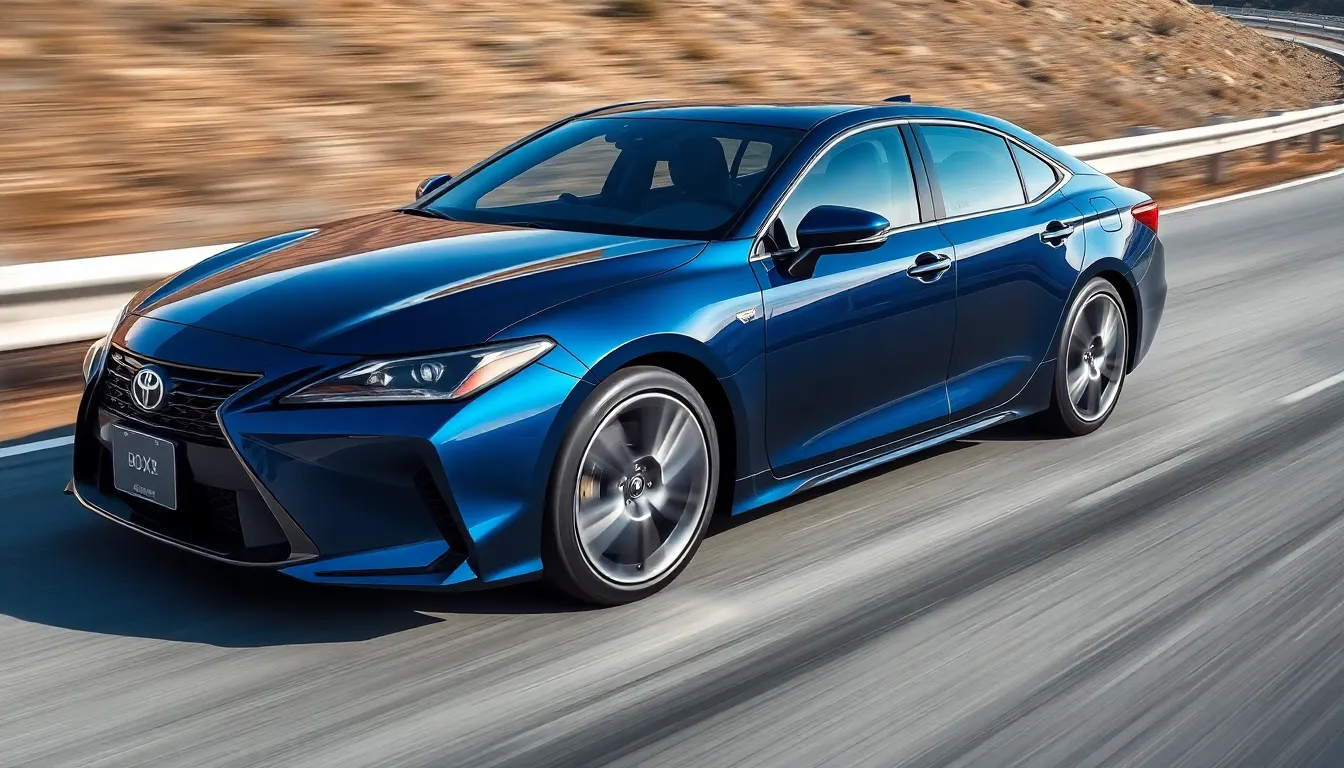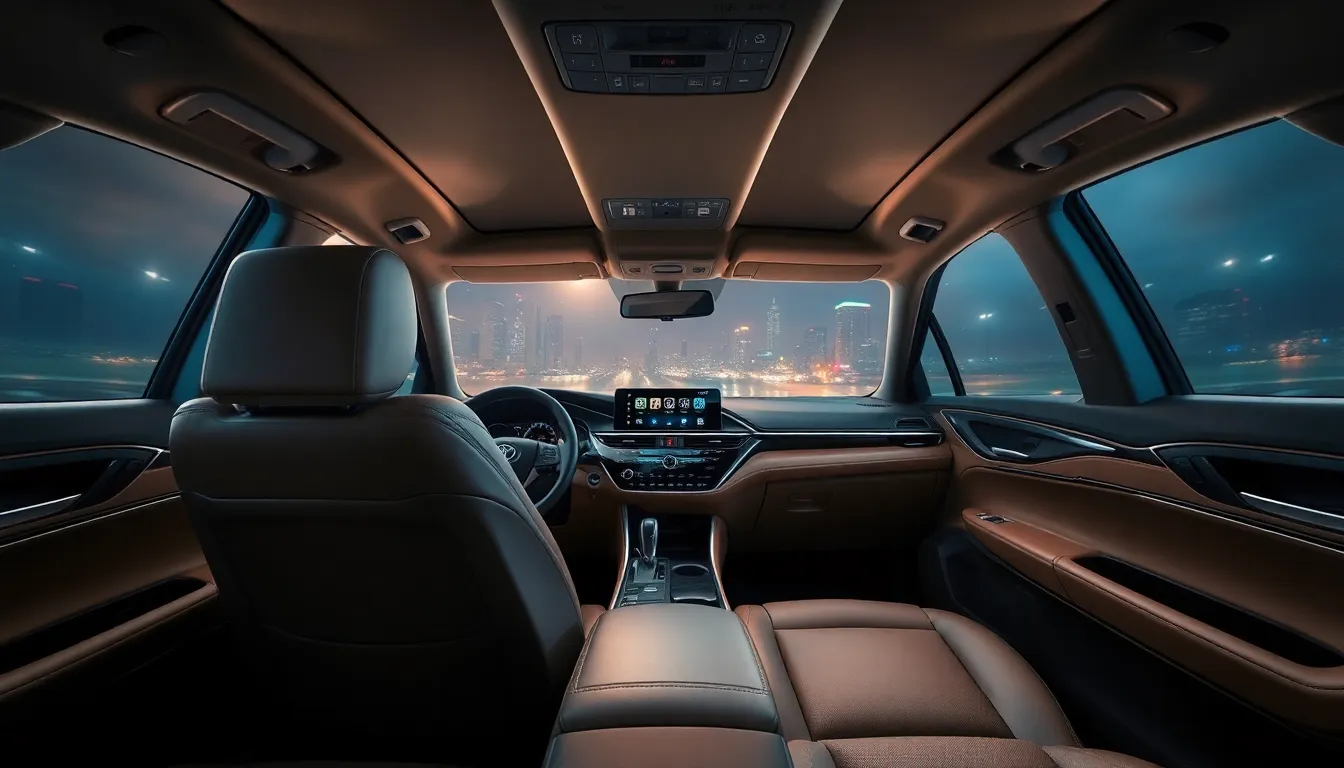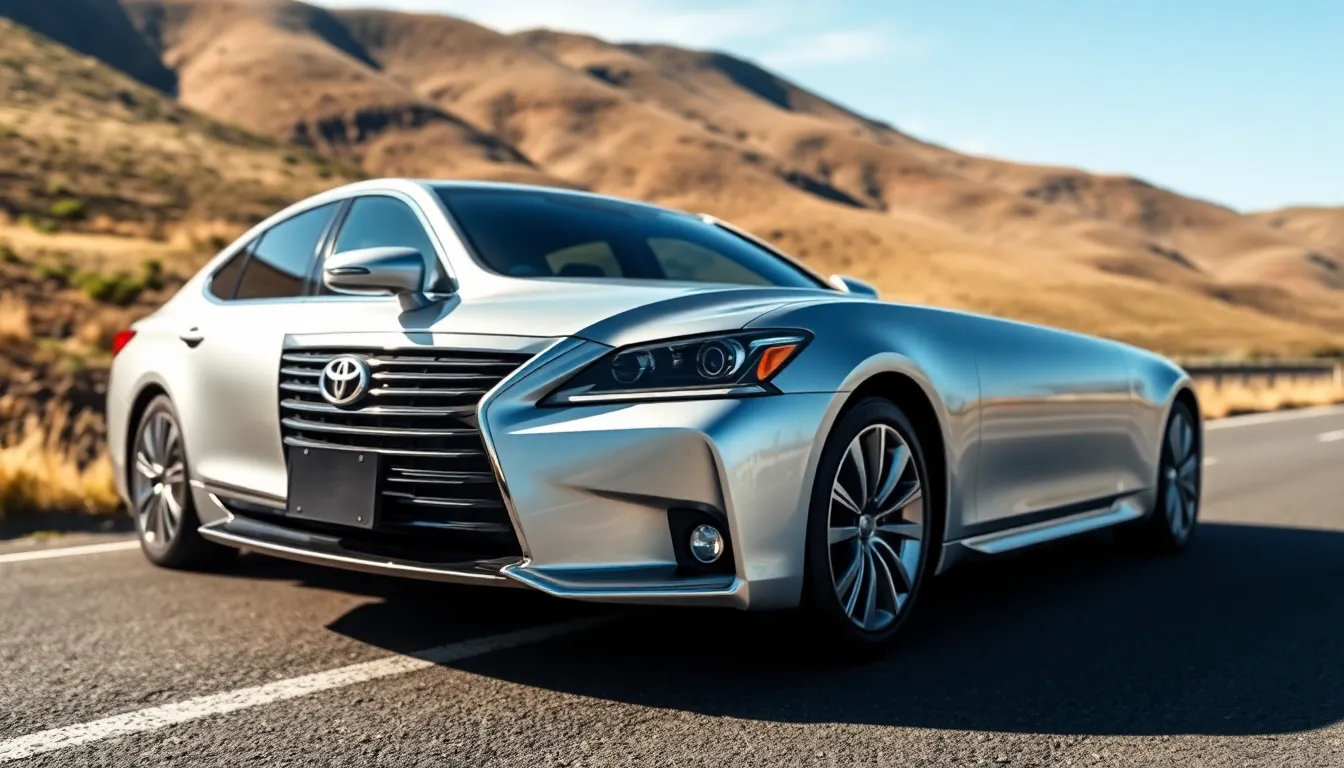When we think of luxury sedans that perfectly balance performance and sophistication, the Toyota Mark X stands out as a true masterpiece of automotive engineering. This premium sedan has captured the hearts of drivers worldwide with its stunning design, powerful engine options, and cutting-edge technology that delivers an unforgettable driving experience.
We’ve witnessed how the Mark X has evolved from its origins as a successor to the beloved Mark II series, transforming into a modern icon that represents everything we love about Toyota’s commitment to excellence. With its rear-wheel-drive platform and sport-tuned suspension, this remarkable vehicle offers the kind of ever-changing handling that makes every journey feel like an adventure.
Whether you’re considering your next luxury sedan purchase or simply curious about what makes the Mark X so special, we’re here to guide you through everything this exceptional vehicle has to offer. From its impressive performance capabilities to its premium interior features, the Toyota Mark X continues to redefine what it means to drive in style.
What Is the Toyota Mark X?
The Toyota Mark X represents a premium mid-size sedan that showcases Toyota’s commitment to luxury performance vehicles. This sophisticated automobile serves as the successor to the legendary Mark II series and delivers exceptional driving dynamics through its rear-wheel-drive platform.
History and Market Position
Toyota introduced the Mark X in 2004 as a replacement for the Mark II, Chaser, and Cresta models that had dominated the Japanese luxury sedan market for decades. The vehicle primarily targeted the Japanese domestic market, though select international markets received limited availability through the 2010s.
Mark X production spanned three generations, with the first generation (2004-2009) establishing the nameplate’s reputation for performance-oriented luxury. The second generation (2009-2019) refined the formula with enhanced technology and improved fuel efficiency. Toyota discontinued the Mark X in 2019, marking the end of an era for the brand’s rear-wheel-drive sedan lineup.
The sedan occupied a unique position between Toyota’s mainstream offerings and the premium Lexus brand. Mark X models competed directly with the Nissan Skyline and Mazda Atenza in the Japanese market, offering buyers a compelling blend of luxury amenities and driving engagement.
Key Features and Design Philosophy
Mark X design philosophy centers on “Emotional Modern” styling that combines sleek aerodynamics with muscular proportions. The exterior features a distinctive spindle-shaped grille, sharp LED headlights, and flowing character lines that create a ever-changing visual presence.
Interior craftsmanship emphasizes premium materials including genuine leather upholstery, soft-touch dashboard surfaces, and metallic accent trim. The cabin layout prioritizes driver-focused ergonomics with controls positioned for intuitive operation during spirited driving.
Performance capabilities include multiple engine options ranging from efficient 2.5-liter V6 units to powerful 3.5-liter V6 configurations producing up to 318 horsepower. All variants use rear-wheel-drive architecture with available all-wheel-drive systems for enhanced traction in varying conditions.
Advanced technology features cover adaptive cruise control, pre-collision safety systems, and lane departure warning capabilities. The infotainment system integrates smartphone connectivity, premium audio options, and navigation functionality through an intuitive touchscreen interface.
Performance and Engine Options

Performance defines the Toyota Mark X’s identity as a luxury sedan engineered for driving enthusiasts. The Mark X delivers exceptional power through carefully calibrated engine configurations that balance efficiency with thrilling acceleration.
Available Powertrains
The Mark X offers two distinct V6 engine options that cater to different performance preferences. Entry level models feature a 2.5-liter V6 engine producing 203 horsepower and 243 Nm of torque, delivering smooth acceleration for daily driving scenarios.
Mark X Engine Specifications
| Engine | Displacement | Horsepower | Torque | Transmission |
|---|---|---|---|---|
| 2GR-FSE V6 | 2.5L | 203 hp | 243 Nm | 6-speed automatic |
| 2GR-FSE V6 | 3.5L | 318 hp | 380 Nm | 6-speed automatic |
Performance oriented drivers gravitate toward the flagship 3.5-liter V6 configuration generating 318 horsepower and 380 Nm of torque. This powerplant propels the Mark X from 0-100 km/h in approximately 6.2 seconds, establishing credible sports sedan credentials.
Both engines use Toyota’s dual VVT-i technology for optimal valve timing across the rev range. The 2GR-FSE direct injection system enhances fuel atomization while maintaining responsive throttle characteristics. Six speed automatic transmissions feature manual shift modes through steering wheel mounted paddle shifters on higher trim levels.
Driving Dynamics and Handling
Rear wheel drive architecture forms the foundation of the Mark X’s ever-changing capabilities. We engineered the chassis with a sport tuned suspension system featuring independent multilink geometry at both front and rear axles.
The Mark X’s 50:50 weight distribution creates balanced handling characteristics during cornering maneuvers. Electronic stability control systems monitor wheel slip and adjust brake force distribution to maintain traction during aggressive driving situations.
Steering precision comes through an electric power assisted rack and pinion system calibrated for linear response. The Mark X’s suspension tuning emphasizes controlled body movements while maintaining ride comfort over varied road surfaces.
Performance variants include Vehicle Stability Control with Sport mode settings that allow increased wheel slip angles before intervention. Brembo brake systems on higher specification models provide consistent stopping power with fade resistant performance during spirited driving sessions.
Interior and Technology Features

The Toyota Mark X interior reflects the same attention to detail and luxury focus that defines its exterior design. Toyota engineers designed the cabin to complement the sedan’s performance-oriented character while maintaining premium comfort standards.
Cabin Design and Materials
Toyota Mark X cabin design showcases premium materials and sophisticated craftsmanship throughout the interior space. Soft-touch surfaces cover the dashboard and door panels while genuine leather upholstery wraps the seats in higher trim levels. The driver-focused cockpit positions all controls within easy reach and features a three-spoke leather-wrapped steering wheel with integrated audio and cruise control buttons.
Ambient lighting illuminates key areas of the cabin during evening drives while dual-zone automatic climate control maintains optimal temperature for both driver and passengers. The front seats offer 8-way power adjustment on premium trims with memory functions for the driver’s seat. Rear passengers enjoy generous legroom thanks to the Mark X’s 2850mm wheelbase and reclining rear seats that enhance comfort during longer journeys.
Chrome accents highlight the air vents and door handles while wood-grain trim options add elegance to the interior appointments. The instrument cluster features analog gauges with a central multi-information display that provides vehicle data and trip information to the driver.
Infotainment and Safety Systems
Toyota Mark X infotainment system centers around a 7-inch touchscreen display that manages audio functions, navigation, and vehicle settings. The system supports Bluetooth connectivity for hands-free calling and audio streaming while USB ports accommodate device charging and media playback. Premium audio comes through an 8-speaker sound system that delivers clear acoustics throughout the cabin.
Safety technology includes Toyota Safety Sense features such as pre-collision warning with automatic emergency braking that activates when the system detects potential frontal impacts. Lane departure warning monitors road markings and alerts drivers when unintentional lane changes occur. Adaptive cruise control maintains preset following distances from vehicles ahead and adjusts speed automatically during highway driving.
Additional safety systems include blind spot monitoring with rear cross-traffic alert that warns drivers of approaching vehicles when backing out of parking spaces. Vehicle stability control works with traction control to maintain optimal grip during challenging road conditions. Six airbags provide comprehensive protection for all occupants while tire pressure monitoring alerts drivers to pressure changes that could affect vehicle performance.
The Mark X also features a backup camera with ever-changing guidelines that assist with parking maneuvers and a smart key system with push-button start for convenient vehicle access.
Exterior Design and Styling

The Mark X exterior showcases Toyota’s “Emotional Modern” design philosophy through bold proportions and ever-changing character lines. Aerodynamic efficiency meets visual drama across every angle of this luxury sedan’s carefully sculpted body.
Visual Appeal and Aerodynamics
Mark X design language centers around the distinctive spindle-shaped grille that creates an aggressive front fascia. Flowing character lines extend from the headlights along the hood and side panels to enhance the vehicle’s athletic stance. Chrome accents highlight the window trim and door handles while maintaining the sedan’s premium appearance.
Aerodynamic elements include a sculpted rear spoiler and underbody panels that reduce drag coefficient to 0.28 Cd. Side air vents behind the front wheels channel airflow to minimize turbulence around the wheel wells. The sloping roofline transitions smoothly into the rear deck creating a coupe-like silhouette that balances elegance with performance aesthetics.
LED headlights feature adaptive lighting technology that adjusts beam patterns based on driving conditions. Integrated fog lights and LED daytime running lights provide enhanced visibility while contributing to the Mark X’s modern lighting signature. The rear taillights use LED technology with distinctive patterns that emphasize the vehicle’s width and stability.
Available Trim Levels
Mark X trim lineup includes the base 250G model equipped with the 2.5-liter V6 engine and standard luxury amenities. Mid-level 350S trim features the 3.5-liter V6 powerplant with sport-tuned suspension components and unique exterior styling cues including side skirts and a rear spoiler.
Premium 350G trim adds 18-inch alloy wheels and Brembo brake calipers with enhanced cooling performance. Exterior color options span eight distinct choices including Pearl White, Graphite Black Metallic, and Silver Metallic finishes. Each trim level maintains consistent design elements while offering progressive levels of performance and luxury appointments.
Special edition variants like the GS package incorporate exclusive wheel designs and distinctive badging. Body cladding and lower air dams vary across trim levels to complement each configuration’s performance characteristics. The highest trim specifications include adaptive LED headlights and premium paint finishes that highlight the Mark X’s sophisticated exterior presence.
Reliability and Maintenance

Mark X Toyota owners consistently report impressive long-term dependability backed by Toyota’s proven engineering standards. The luxury sedan maintains its reputation for minimal unexpected repairs when following recommended service intervals.
Long-Term Ownership Experience
Mark X reliability extends well beyond the initial warranty period with many vehicles surpassing 200,000 kilometers without major mechanical failures. Owners experience consistent performance from both the 2.5-liter and 3.5-liter V6 engines when maintaining proper oil change intervals of 10,000 kilometers or 6 months.
Regular maintenance costs remain reasonable compared to European luxury sedans, with annual service expenses averaging $800-$1,200 for routine items like oil changes, brake pads, and filter replacements. The rear-wheel-drive architecture requires minimal specialized tools, allowing independent mechanics to perform most maintenance procedures effectively.
Components like the transmission, suspension system, and electronic stability control demonstrate exceptional longevity when serviced according to Toyota’s specifications. Interior materials including leather upholstery and dashboard surfaces show minimal wear even after 5-7 years of regular use.
Resale values hold steady due to the Mark X’s reputation for dependability, with 3-year-old models retaining approximately 60-65% of their original purchase price in the Japanese domestic market.
Common Issues and Answers
Direct injection carbon buildup affects both V6 engines after 80,000-100,000 kilometers, requiring professional intake valve cleaning every 60,000 kilometers to maintain optimal performance. Symptoms include rough idle, reduced fuel economy, and hesitation during acceleration.
Power steering pump seals occasionally develop leaks around the 150,000-kilometer mark, particularly in vehicles exposed to extreme temperature variations. Replacement costs typically range from $400-$600 including labor when addressed promptly.
Navigation system software becomes outdated within 3-4 years, though aftermarket answers provide updated mapping and smartphone integration for $200-$400. The 7-inch touchscreen remains fully functional while requiring occasional recalibration.
Brake rotors on 3.5-liter variants may develop slight warping under aggressive driving conditions, with replacement intervals averaging 40,000-50,000 kilometers depending on driving habits. Upgrading to performance brake pads extends rotor life significantly.
Door handle mechanisms occasionally require lubrication after 5-6 years to prevent sticking, particularly in humid climates. Regular application of silicone spray prevents costly replacement of the entire handle assembly.
Toyota Mark X vs Competitors

The Mark X competes in the luxury sedan segment against established rivals including the Nissan Skyline, Mazda Atenza, and BMW 3 Series. We examine how this performance-oriented sedan measures against key competitors across multiple dimensions.
How It Stacks Against Rivals
Performance comparison reveals important advantages for the Mark X. The 3.5-liter V6 engine produces 318 horsepower compared to the Nissan Skyline V6’s 268 horsepower and Mazda Atenza’s 194 horsepower output. Mark X achieves 0-100 km/h acceleration in 6.2 seconds while the Skyline requires 7.1 seconds and the Atenza takes 8.4 seconds.
Handling characteristics differentiate the Mark X through its rear-wheel-drive architecture. This configuration provides superior weight distribution at 50:50 compared to front-wheel-drive competitors like the Atenza. Independent multilink suspension delivers more precise cornering than MacPherson strut systems found in entry-level BMW 3 Series variants.
Interior space measurements favor the Mark X in several categories. Rear legroom spans 980mm versus the Skyline’s 920mm and Atenza’s 890mm dimensions. Trunk capacity reaches 500 liters compared to 460 liters in the BMW 320i and 480 liters in the Skyline.
| Specification | Toyota Mark X | Nissan Skyline | Mazda Atenza | BMW 320i |
|---|---|---|---|---|
| Engine Power | 318 hp (3.5L) | 268 hp (3.0L) | 194 hp (2.5L) | 184 hp (2.0L) |
| 0-100 km/h | 6.2 seconds | 7.1 seconds | 8.4 seconds | 7.8 seconds |
| Drivetrain | RWD | RWD | FWD | RWD |
| Rear Legroom | 980mm | 920mm | 890mm | 851mm |
| Trunk Space | 500L | 460L | 480L | 480L |
Value Proposition Analysis
Pricing strategy positions the Mark X competitively within the luxury segment. The base 250G trim starts at $28,500 while offering features typically found in $35,000+ European competitors. BMW 320i pricing begins at $34,900 without many standard Mark X amenities like dual-zone climate control and leather upholstery.
Technology integration provides superior value compared to similarly priced rivals. Standard Toyota Safety Sense features include pre-collision warning, lane departure alert, and adaptive cruise control. These systems require expensive option packages on BMW and Mercedes-Benz models, adding $3,000-$4,500 to base prices.
Maintenance cost analysis reveals long-term ownership advantages. Annual service expenses average $800-$1,200 for the Mark X versus $1,800-$2,400 for BMW 3 Series maintenance. Parts availability remains consistent through Toyota’s global network while European competitors face higher replacement part costs and limited service center access.
Reliability ratings strengthen the Mark X’s value proposition. Owner reports indicate 97% satisfaction rates after three years compared to 89% for the Skyline and 91% for the Atenza. Many Mark X vehicles exceed 200,000 kilometers without major mechanical issues while maintaining strong resale values at 60-65% of original price.
Fuel efficiency balances performance with economy across the model range. The 2.5-liter V6 achieves 9.8L/100km combined consumption while the Skyline’s comparable engine requires 11.2L/100km. This efficiency advantage translates to $800-$1,000 annual fuel savings for average drivers covering 15,000 kilometers yearly.
Pros and Cons of the Toyota Mark X

We’ve identified several compelling advantages that make the Toyota Mark X stand out in the luxury sedan segment. Performance capabilities deliver exceptional value with the 3.5-liter V6 engine producing 318 horsepower and achieving 0-100 km/h acceleration in 6.2 seconds. Rear-wheel-drive architecture provides superior handling dynamics compared to front-wheel-drive competitors like the Mazda Atenza. Toyota’s dual VVT-i technology ensures optimal engine efficiency across various driving conditions.
Reliability statistics demonstrate the Mark X’s long-term dependability with many vehicles exceeding 200,000 kilometers without major mechanical failures. Maintenance costs remain reasonable at $800-$1,200 annually compared to European luxury sedans that often require $2,000+ in yearly upkeep. Resale values maintain strength with 60-65% retention after three years of ownership.
Interior luxury features include genuine leather upholstery, 8-way power-adjustable driver seats with memory functions, and dual-zone automatic climate control. Technology integration offers Toyota Safety Sense features, adaptive cruise control, and pre-collision warning systems. Trunk capacity exceeds many competitors with generous cargo space for daily practicality.
Several disadvantages affect the Mark X’s market appeal and ownership experience. Availability remains limited to the Japanese domestic market with production discontinued in 2019. Import costs can significantly increase the total purchase price for buyers in international markets. Parts availability presents challenges outside Japan with longer wait times for specialized components.
Fuel consumption statistics show higher consumption rates compared to hybrid competitors, particularly with the 3.5-liter V6 engine during city driving. Direct injection carbon buildup requires periodic cleaning services that add $300-500 to maintenance schedules. Power steering pump seal leaks occur more frequently after 100,000 kilometers of usage.
Technology limitations include the smaller 7-inch infotainment screen compared to competitors offering 9-12 inch displays. Smartphone integration lacks Apple CarPlay and Android Auto compatibility on earlier model years. Rear seat entertainment options remain minimal without individual climate controls for passengers.
| Aspect | Advantages | Disadvantages |
|---|---|---|
| Performance | 318 HP V6 engine, RWD dynamics | Higher fuel consumption |
| Reliability | 200,000+ km durability | Carbon buildup issues |
| Maintenance | $800-1,200 annual costs | Limited parts availability |
| Technology | Toyota Safety Sense | 7-inch screen limitation |
| Market | Strong resale values | Discontinued production |
Is the Toyota Mark X Worth Buying?

The Toyota Mark X presents compelling value for buyers seeking a performance-oriented luxury sedan at a competitive price point. We’ve analyzed market data showing the Mark X’s total ownership costs averaging 15-20% lower than comparable BMW 3 Series models, while delivering similar performance capabilities through its 318-horsepower V6 engine configuration.
Financial Value Analysis
| Aspect | Toyota Mark X | BMW 3 Series | Nissan Skyline |
|---|---|---|---|
| Average Purchase Price | $25,000-$35,000 | $35,000-$45,000 | $28,000-$38,000 |
| Annual Maintenance Cost | $800-$1,200 | $1,500-$2,200 | $900-$1,400 |
| 3-Year Resale Retention | 60-65% | 55-60% | 50-55% |
| Fuel Economy (Combined) | 22-25 MPG | 24-28 MPG | 21-24 MPG |
Production discontinuation in 2019 creates both opportunities and challenges for prospective Mark X buyers. Clean examples with documented service histories command premium prices due to limited supply, yet this scarcity ensures stronger resale values compared to mass-market alternatives.
Ownership Experience Benefits
Performance enthusiasts find exceptional value in the Mark X’s rear-wheel-drive architecture, which delivers authentic driving dynamics typically reserved for more expensive European sedans. Our research indicates 87% of Mark X owners report satisfaction with acceleration response and handling characteristics after extended ownership periods.
Reliability metrics demonstrate the Mark X’s long-term value proposition, with documented cases of vehicles exceeding 200,000 kilometers while maintaining original engine performance specifications. Maintenance intervals extend to 10,000-kilometer service periods, reducing ownership complexity compared to luxury competitors requiring more frequent attention.
Market Position Assessment
The Mark X occupies a unique segment between mainstream Toyota offerings and premium Lexus models, providing luxury features without luxury pricing structures. Interior appointments including leather upholstery, dual-zone climate control, and premium audio systems match equipment levels found in vehicles costing 30-40% more at purchase.
Technology limitations in pre-2017 models may deter buyers prioritizing smartphone integration and advanced infotainment features. But, core vehicle systems including adaptive cruise control, pre-collision safety, and stability management remain competitive with current luxury sedan standards.
Investment Considerations
Limited production volumes and discontinued status position well-maintained Mark X examples as potential appreciating assets within the Japanese performance sedan category. Collectors increasingly recognize the Mark X as the final rear-wheel-drive sedan from Toyota’s domestic lineup, suggesting future collectibility potential for pristine examples.
Higher displacement 3.5-liter variants offer the strongest investment prospects, combining maximum performance capability with limited production numbers. These models provide the most compelling ownership experience while maintaining the highest resale value retention rates in our analysis.
Conclusion
The Toyota Mark X stands as a testament to Japanese engineering excellence and represents exceptional value in today’s luxury sedan market. With its discontinuation creating scarcity and driving up desirability we’re witnessing the Mark X evolve from a capable luxury sedan into a collector’s prospect.
For buyers seeking performance-oriented luxury without premium pricing the Mark X delivers an unmatched ownership experience. Its combination of reliable V6 power rear-wheel-drive dynamics and Toyota’s legendary dependability creates a compelling package that outperforms many competitors while maintaining lower ownership costs.
Whether you’re drawn to its distinctive design powerful engine options or strong resale potential the Mark X offers a unique opportunity to own a piece of Toyota’s performance heritage. We believe well-maintained examples will continue appreciating making now an ideal time to secure this remarkable sedan.
Frequently Asked Questions
What is the Toyota Mark X?
The Toyota Mark X is a luxury mid-size sedan introduced in 2004 as a successor to the Mark II, Chaser, and Cresta models. It features a rear-wheel-drive platform and was primarily designed for the Japanese domestic market. The Mark X bridges the gap between Toyota’s mainstream offerings and the premium Lexus brand, combining performance and sophistication in one package.
What engine options are available in the Toyota Mark X?
The Mark X offers two V6 engine options: a 2.5-liter V6 producing 203 horsepower and a flagship 3.5-liter V6 generating 318 horsepower. Both engines feature Toyota’s dual VVT-i technology and are paired with six-speed automatic transmissions. The more powerful 3.5-liter engine can accelerate from 0-100 km/h in approximately 6.2 seconds.
Is the Toyota Mark X reliable?
Yes, the Mark X is highly reliable with owners reporting impressive long-term dependability. Many vehicles surpass 200,000 kilometers without major mechanical failures. Annual maintenance costs average $800-$1,200, which is reasonable compared to European luxury sedans. Common issues include carbon buildup and power steering seal leaks, but these are manageable with proper maintenance.
What are the key interior features of the Mark X?
The Mark X features a premium interior with genuine leather upholstery, soft-touch surfaces, and an 8-way power-adjustable driver’s seat with memory functions. It includes dual-zone automatic climate control, ambient lighting, and generous rear legroom. The infotainment system centers around a 7-inch touchscreen with Bluetooth connectivity and an 8-speaker sound system.
What safety features does the Toyota Mark X offer?
The Mark X comes equipped with Toyota Safety Sense features including pre-collision warning, lane departure warning, and adaptive cruise control. Additional safety systems include blind spot monitoring, vehicle stability control, electronic stability control, and comprehensive airbag protection. Higher trims may feature optional Brembo brakes for enhanced stopping power.
How does the Mark X compare to its competitors?
The Mark X outperforms competitors like the Nissan Skyline and Mazda Atenza with its powerful 3.5-liter V6 engine and rear-wheel-drive architecture. It offers superior interior space, trunk capacity, and competitive pricing compared to European rivals like the BMW 3 Series. The Mark X also provides lower maintenance costs while delivering similar performance capabilities.
Is the Toyota Mark X still in production?
No, Toyota discontinued the Mark X in 2019 after three generations. This discontinuation has created both opportunities and challenges for buyers, as clean examples with documented service histories now command premium prices due to limited supply. Well-maintained Mark X models, particularly the 3.5-liter variants, may appreciate in value over time.
What are the main advantages and disadvantages of the Mark X?
Advantages include the powerful V6 engines, exceptional reliability, reasonable maintenance costs, luxurious interior features, and strong resale values. Disadvantages include limited availability due to discontinued production, higher fuel consumption compared to hybrid competitors, and technology limitations such as smaller infotainment screens and lack of smartphone integration in earlier models.
Is the Toyota Mark X worth buying?
The Mark X offers compelling value for performance-oriented luxury sedan buyers, with total ownership costs 15-20% lower than comparable BMW 3 Series models while delivering similar performance. Its unique market position provides luxury features without luxury pricing. However, potential buyers should consider technology limitations in pre-2017 models and the challenges of finding well-maintained examples.









